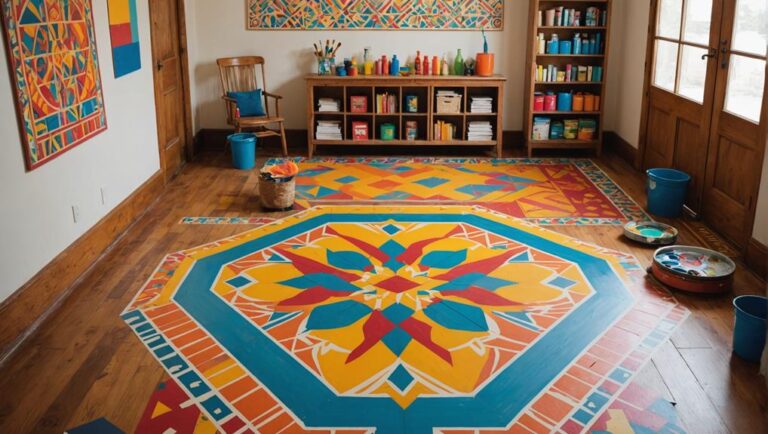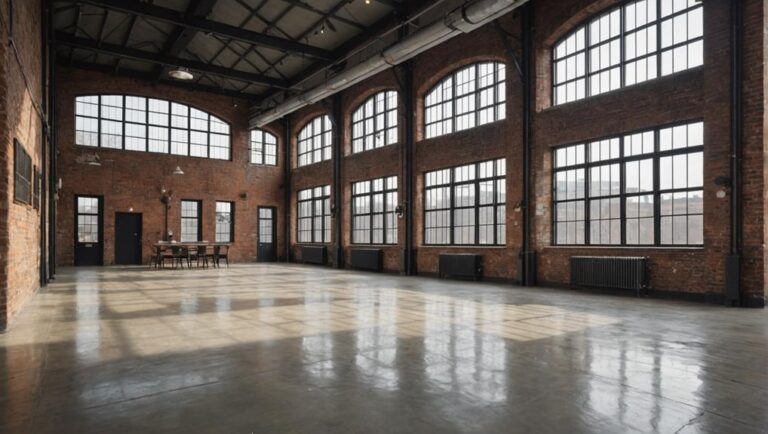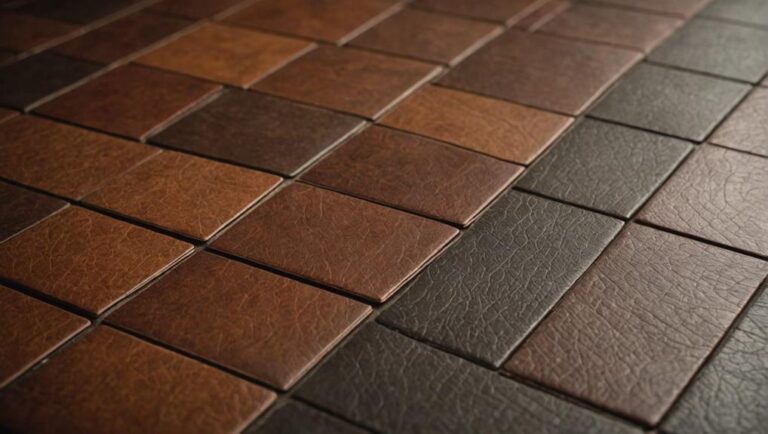To achieve a high-end flooring look on a budget, start by choosing cost-effective materials like laminate or luxury vinyl that mimic hardwood or stone. Opt for neutral color palettes to create a sophisticated backdrop, and use area rugs strategically to define spaces and add warmth. Layering textures can enhance depth and visual interest, while stylish trim and molding elevate the overall aesthetic. Don't shy away from DIY projects; upcycling can add unique charm at a fraction of the cost. These simple strategies can transform your space beautifully, and there's much more to discover that can elevate your flooring game even further.
Choose the Right Flooring Material
When it comes to choosing the right flooring material, balancing style and budget is key. The flooring trends today lean towards a mix of aesthetics and practicality, making it easier for you to find options that suit your taste without breaking the bank. You'll want to take into account materials that not only look great but also offer material durability, ensuring they can withstand daily wear and tear.
Laminate and luxury vinyl are popular choices that mimic the look of hardwood or stone without the hefty price tag. These materials are not only stylish but also resistant to scratches, making them ideal for households with pets or children. Plus, they're easy to maintain, which adds to their appeal. If you're seeking something more natural, bamboo or cork flooring can be excellent eco-friendly options. They provide a unique look while being surprisingly durable and sustainable.
Additionally, remember to reflect on safety. Some flooring options come with slip-resistant surfaces, which can be vital in areas like kitchens and bathrooms. This evaluation can help prevent accidents while enhancing the aesthetic appeal of your space.
Ultimately, your flooring choice should reflect your personal style while providing the durability needed for everyday life. By carefully evaluating your options, you can create a beautiful space that's both safe and budget-friendly, ensuring you enjoy your flooring for years to come.
Opt for Neutral Color Palettes
Choosing a neutral color palette can transform your space while keeping costs down. Neutral colors create a calming environment, making your home feel more spacious and inviting. When you opt for shades like beige, gray, or soft whites, you can establish a minimalist decor style that looks sophisticated yet approachable.
A neutral base allows you to play with various textures and materials without overwhelming the senses. For instance, consider using wood or stone flooring in a neutral hue to set a solid foundation. This way, you can easily complement your flooring with furniture and décor that enhances the overall aesthetic.
Incorporating accent colors into your design can add personality without breaking the bank. Think about how a few well-placed pops of color—like vibrant cushions, artwork, or decorative throws—can breathe life into your neutral palette. You can choose bold colors that contrast with the soft tones of your floors, or go for subtle shades that maintain the calm vibe of minimalist decor.
Additionally, neutral palettes are timeless. As trends come and go, your space will remain stylish and sophisticated, making it a smart investment. By focusing on these safe, neutral tones, you'll create a harmonious environment that feels both luxurious and welcoming. So, embrace the power of neutral colors, and watch as your home transforms into a chic sanctuary.
Use Area Rugs Strategically
Area rugs can be a game-changer in your flooring design, adding warmth and texture without a hefty price tag. By using strategic rug placement, you can define spaces within a room, creating cozy areas for lounging or dining. For example, place a rug beneath your coffee table to anchor your seating arrangement, making the space feel intentional and inviting.
When choosing an area rug, consider the size and shape in relation to your furniture. A rug that's too small can make a room feel disjointed, while one that's too large may overwhelm your space. Ideally, the front legs of your furniture should sit on the rug, promoting a unified look.
Don't forget about rug maintenance; keeping your rugs clean is essential for safety and longevity. Regular vacuuming helps remove dirt and allergens, while spot cleaning can address spills before they become stains. If you have pets or kids, opt for durable materials that can withstand wear and tear.
Lastly, consider the rug's texture and color to enhance your overall aesthetic. A plush rug can add comfort, while a flat-weave option may be better for high-traffic areas. By choosing the right area rug and placing it thoughtfully, you can elevate your home's design without compromising safety or breaking the bank. So go ahead, give your floors the upgrade they deserve with these simple yet effective tips!
Incorporate Layering Techniques
Layering techniques can transform your floors into a cozy and inviting space without breaking the bank. By choosing complementary textures, you can create visual interest and depth. Don't forget to mix in area rugs to add warmth and define different zones in your room.
Choose Complementary Textures
Textures can transform a space, adding depth and character without breaking the bank. When you choose complementary textures, you create a visually appealing environment that feels rich and inviting. Think about texture combinations that offer tactile contrast. For example, pairing a sleek, polished wood floor with a soft, plush area rug can elevate your room's overall look while guaranteeing comfort underfoot.
Experiment with various materials to achieve a layered effect. Consider combining ceramic tiles with natural fiber mats, or mixing hardwood with stone accents. This not only enhances visual interest but also guarantees safety, as different textures can provide better grip and reduce the risk of slips.
Don't shy away from bold choices; even small elements can make a big impact. A woven basket can introduce warmth alongside smooth surfaces, while a chunky knit throw can soften hard lines. These thoughtful combinations can help you achieve a high-end aesthetic without overspending. Just remember to keep the balance in mind—too many contrasting textures can create chaos rather than harmony. Focus on those that complement each other, and your space will feel both luxurious and inviting.
Use Area Rugs
Incorporating area rugs into your design can elevate your space while providing both comfort and style. Layering area rugs is a fantastic way to achieve a high-end look without breaking the bank. Start by choosing a larger base rug that complements your flooring and sets the tone for the room. Then, select a smaller, decorative rug that adds texture and visual interest. Mixing different area rug sizes can create depth and warmth in your space, making it feel inviting.
When layering, be mindful of safety. Make certain that the edges of your rugs are secured to prevent tripping hazards. Use non-slip rug pads to keep everything in place. For rug maintenance, regularly vacuum both rugs to keep them looking fresh and clean. Consider using a damp cloth for spot cleaning any spills or stains.
Add Stylish Trim and Molding
Adding trim and molding can transform your floors from basic to beautiful without breaking the bank. You'll find a variety of trim options to fit your style, and with some DIY installation tips, it's easier than you think. Plus, choosing the right color and finish can tie your whole design together seamlessly.
Types of Trim Options
Transforming your floors can be as simple as choosing the right trim options. Adding stylish trim and molding not only enhances the aesthetic of your space but also provides a polished, high-end look. Here are some trim options to evaluate:
- Baseboard Styles: Choose from traditional, modern, or farmhouse styles. A taller baseboard can create an impressive visual height.
- Crown Molding: This adds elegance by bridging the gap between walls and ceilings. Opt for a simple design for a subtle touch, or go bold with intricate patterns.
- Quarter Round: This small trim piece can cover gaps between flooring and baseboards, ensuring a clean finish.
- Chair Rails: Placing chair rails at mid-wall height can add dimension and protect your walls from wear and tear.
- Window and Door Casings: Dress up your windows and doors with decorative casings for a cohesive look throughout your space.
Selecting the right trim options not only elevates your floor design but also enhances safety by reducing the likelihood of tripping hazards with well-fitted pieces. So, explore these choices to find the perfect match for your style!
DIY Installation Tips
While you might think adding trim and molding to your floors is a job for the pros, tackling it yourself can be both rewarding and cost-effective. With the right flooring tools and installation techniques, you can elevate your space without breaking the bank.
Here's a handy table to help guide your DIY project:
| Tool | Purpose | Tips |
|---|---|---|
| Miter Saw | Precise angle cuts | Always wear safety goggles. |
| Nail Gun | Quick installation | Practice on scrap wood first. |
| Measuring Tape | Accurate measurements | Double-check before cutting. |
| Level | Guarantees even installation | Use it after every piece. |
Before you start, gather your tools and plan your layout. Confirm you're working in a well-ventilated area and wearing appropriate protective gear. Measure carefully and cut each piece precisely to avoid mistakes. Take your time with each installation technique; precision is key to achieving that high-end look. With a little patience and creativity, you'll transform your floors into something truly special!
Color and Finish Choices
Once you've tackled the installation, the next step is to choose the right colors and finishes for your trim and molding. This not only enhances your design but also adds a touch of sophistication without breaking the bank. Remember, color psychology plays an essential role in how a space feels. Soft, neutral tones create calmness, while bold colors can energize a room.
When selecting finishes, consider durability. You want your trim and molding to withstand wear and tear while maintaining an elegant appearance. Here are some tips to keep in mind:
- Choose complementary colors: Confirm your trim contrasts nicely with your flooring.
- Opt for semi-gloss or satin finishes: These offer durability and reflect light beautifully.
- Consider the style of your home: Traditional homes may benefit from classic white, while modern spaces can handle darker shades.
- Test samples before committing: Paint swatches can look different on your walls.
- Incorporate decorative molding: This adds dimension and visual interest without high costs.
Embrace DIY Projects
Often, embracing DIY projects can breathe new life into your flooring without draining your wallet. With a little creativity and some elbow grease, you can achieve a high-end look while keeping safety in mind. Start by considering upcycling materials; these can add unique character and charm while being environmentally friendly. Look for reclaimed wood, pallets, or even old tiles that can serve as the foundation for your new flooring.
Before diving in, gather your budget-friendly tools. Don't underestimate the power of a good sander, paintbrush, and adhesive. These essentials not only make your project easier but also guarantee your results are polished and professional. Remember, safety first! Always wear protective gear and ensure your workspace is clear of hazards.
Consider creating a stunning feature floor by using a combination of painted designs and stenciling techniques. This approach can transform basic flooring into a one-of-a-kind masterpiece. If you're feeling adventurous, try your hand at making a mosaic from broken tiles or glass. This method is a fantastic way to repurpose materials while adding a personal touch.
Lastly, don't forget to finish your project with a protective sealant. This will not only enhance the look but also keep your flooring durable and safe for daily use. By embracing DIY, you'll find that high-end flooring doesn't have to come with a hefty price tag—just your creativity and a bit of hard work!
Frequently Asked Questions
What Are the Best Budget-Friendly Flooring Materials to Consider?
Imagine walking through a lush forest, where every step feels soft underfoot. For your home, think of laminate options, like stepping onto that forest floor. Vinyl planks mimic nature beautifully, while cork flooring offers eco-friendly choices. Tile alternatives add charm, and luxury vinyl brings elegance. Don't overlook carpet selections for warmth and comfort, or engineered wood for a refined touch. Each option can transform your space, making it feel safe and inviting without breaking the bank.
How Can I Maintain My Floors to Keep Them Looking High-End?
To keep your floors looking high-end, you need to focus on regular floor cleaning and protection. Sweep or vacuum frequently to remove dirt and debris that can scratch surfaces. Use a damp mop with a gentle cleaner suitable for your flooring type, avoiding harsh chemicals. Consider placing rugs in high-traffic areas to protect against wear and tear. Finally, address spills immediately to prevent stains and maintain that pristine appearance you desire.
Are There Specific Brands Known for Affordable Luxury Flooring?
If you're searching for affordable luxury flooring, consider brands like Mohawk and Shaw, known for their luxury laminate and vinyl planks. These options offer stunning visuals and durability without breaking the bank. Look for features like scratch resistance and water protection to guarantee safety and longevity. You'll appreciate how these materials can elevate your space while keeping maintenance easy and costs low. It's a smart choice for a high-end feel on a budget.
How Do I Choose the Right Area Rug Size for My Space?
Choosing the right area rug size starts with considering your space and furniture arrangement. For a cohesive look, guarantee the front legs of your furniture sit on the rug. Measure your room, then select a rug that complements it without overcrowding. Think about rug placement; a larger rug can unify a room, while a smaller one can define areas. Don't forget rug materials—opt for non-slip options to enhance safety while adding style.
What Common Mistakes Should I Avoid When Designing My Floors?
When designing your floors, it's essential to avoid common mistakes that can affect your space's overall look. First off, don't overlook color selection; choose hues that complement your decor. Also, be aware of flooring trends—sticking to outdated styles can make your home feel less inviting. Finally, make sure you consider safety; slip-resistant materials are a must. By avoiding these pitfalls, you'll create a stylish, safe environment that reflects your personality.




